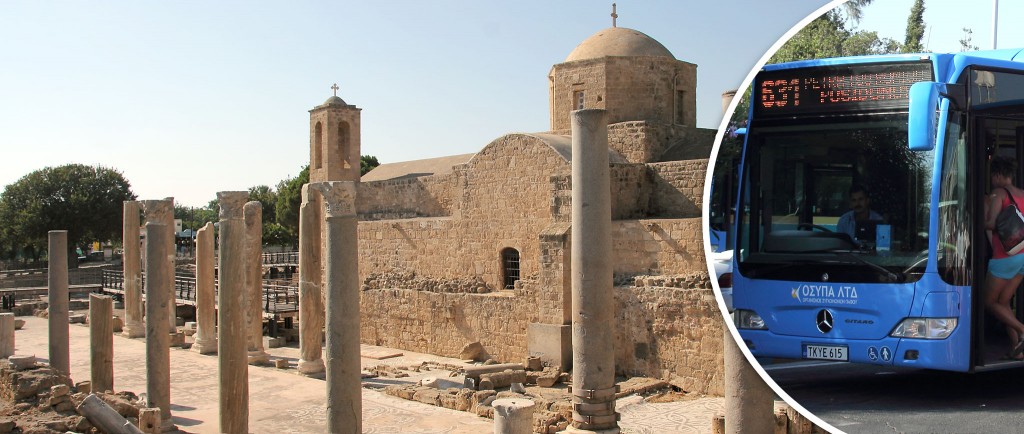The route links the old Paphos harbour with the world famous place where, according to legend, the Goddess Aphrodite emerged from the sea – Petra Tou Romiou.
Take a relaxing and comfortable trip here by the number 631 bus.
The start of the Kato Paphos route
The bus makes several stops, passing the tourist area of Paphos (ref. schedule and map of the route).
The bus does 10 shuttles a day and keeps strictly to its schedule. One way is €1.50. Ample room and air conditioning make the drive comfortable.
After several stops in the tourist section, you will pass through an industrial area and cross the border of the city. The beautiful scenery sails past – the houses smothered in flowers and greenery, fields, vineyards and olive orchards.
Kouklia, the oldest city in Cyprus
The bus stops. There used to be a famous shrine devoted to the goddess, Aphrodite here, but in the 14th century it was destroyed by an earthquake. A church, dedicated to the Most Holy Mother, Panhagia Katoliki, was subsequently built on the spot.
We are driving further along next to the sea – only a narrow strip of land separates the road from the water. It’s certainly an amazing view.
The last turn and we enter the Aphrodite Hills complex – a huge area designed for comfort, relaxation and entertainment, with apartments, villas, a golf club with perfectly trimmed greens and complex sand traps, a five star hotel, village square with cafes and restaurants and a children’s playground. Plan to spend some time here on your way back.
The end of the route – Petra Tou Romiou (Aphrodite Stones)
And we move further, to the last stop, Petra Tou Romiou. The bus parks on the square where there is a kiosk-café. Here you can buy water and use the toilet facilities.
The whole journey takes about 45 minutes. By the way, I can recommend restaurants in both Aphrodite Hills or Kato Paphos.
The Stones of Aphrodite is a picturesque place, where hundreds of tourists visit each year. Go down from the parking lot, passed the café, and a narrow tunnel under the road will lead you to the sea. When you emerge from under the stone arch, you will find yourself on a beautiful beach where hearts have been laid out in stone by lovers and newly-weds. You can go swimming or just take a walk along the beach.
Antiquities of the Old Harbour
Remember to visit the old harbour when you return to Kato Paphos. There is an open air museum nearby (map: C), where archeologists unearthed the remains of an ancient city from the 1st-2nd century A.D. The foundations of buildings, mosaics and some everyday items are wonderfully preserved.
If you move half a kilometre from the bus stop away from the sea, you will see a very unusual sight – a tree with many scraps of cloth tied to it (map: F).
This mighty tree’s roots go down into the cave of the martyr, Solimonia. In the 2nd century A.D., Christians hid here during the bloody persecutions, and performed church services in secret.
Turning back to the sea, walk about 30 metres to the left, a parallel road will lead you down to an old square. A column, near where Saint Paul was whipped (map: A) is preserved here. The events are mention in the Book of Acts, chapter 13; the Biblical city of Paph was the capital of Cyprus.
The Baths and a cosy Café
Walk along the shore in the opposite direction from the old harbour, and you will come to the famous Baths (μπανια – Baths in Greek, map: G). There is a comfortable entrance into the water, showers, lockers and an interesting stone floor.
Don’t forget to take a snorkel with you if you’re planning on swimming here. There is the Alea café nearby (map: B) with welcoming staff and a magnificent sea view.
There is a special mix of aromas, feelings and emotions here, the place is steeped in history – to think that in this very same place, two thousand years ago, people were also admiring the sea and the sunset just as they do today.
